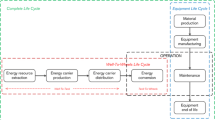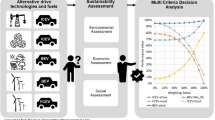Abstract
Life cycle assessment (LCA) will always involve some subjectivity and uncertainty. This reality is especially true when the analysis concerns new technologies. Dealing with uncertainty can generate richer information and minimize some of the result mismatches currently encountered in the literature. As a way of analyzing future fuel cell vehicles and their potential new fuels, the Fuel Upstream Energy and Emission Model (FUEEM) developed at the University of California—Davis, pioneered two different ways to incorporate uncertainty into the analysis. First, the model works with probabilistic curves as inputs and with Monte Carlo simulation techniques to propagate the uncertainties. Second, the project involved the interested parties in the entire process, not only in the critical review phase. The objective of this paper is to present, as a case study, the tools and the methodologies developed to acquire most of the knowledge held by interested parties and to deal with their — eventually conflicted—interests. The analysis calculation methodology, the scenarios, and all assumed probabilistic curves were derived from a consensus of an international expert network discussion, using existing data in the literature along with new information collected from companies. The main part of the expert discussion process uses a variant of the Delphi technique, focusing on the group learning process through the information feedback feature. A qualitative analysis indicates that a higher level of credibility and a higher quality of information can be achieved through a more participatory process. The FUEEM method works well within technical information and also in establishing a reasonable set of simple scenarios. However, for a complex combination of scenarios, it will require some improvement. The time spent in the process was the major drawback of the method and some alternatives to share this time cost are suggested.
Similar content being viewed by others
References
Acurex Environmental Corporation (1996): Evaluation of Fuel-Cycle Emissions on a Reactivity Basis. 2 volumes. Prepared for CARB. A166–134. Principal Authors: Unnasch S, Browning L, Montano M
Al-Alawi S M, Islam S M (1996): Principles of Electricity Demand Forecasting. Part 1: Methodologies. Power Engineering Journal. June, pp. 139–143
Armstrong JS (1985): Long Range Forecasting: From Crystal Ball to Computer. 2nd ed, Wiley-Interscience Publication, New York
Armstrong JS (1999): Introduction to Paper and Commentaries on the Delphi Technique. International Journal of Forecasting 15, 351–352
Armstrong JS, Collopy F (1993): Casual Forces: Structuring Knowledge for Time Series Extrapolation. Journal of Forecasting 12, 103–115
Ayton P, Ferrel WR, Stewart, TR (1999): Commentaries On ‘The Delphi Technique as a Forecasting Tool: Issues and Analysis’ by Rowe and Wright. International Journal of Forecasting 15, 377–381
Belson William A (1981): The Design and Understanding of Survey Questions. Gower Publishing Co, Aldershot, England
Brockhoff, K (1984): Forecasting Quality and Information. Journal of Forecasting 3, 417–428
Clemen, Robert T (1985): Extraneous Expert Information. Journal of Forecasting 4, 329–348
Contadini JF (2000): Life-cycle Emissions and Energy Requirement of Fuel Cell Vehicles Use in 2010: Dealing with Uncertainties. Thesis Proposal. Department of Civil and Environmental Engineering. University of California at Davis
Contadini JF, Moore RM, Sperling D, Sundaresan M (2000a): Life-cycle Emissions of Alternative Fuels for Transportation: Dealing with Uncertainties. Society of Automotive Engineers, Inc; SAE 2000–01–0597
Contadini JF, Diniz CV, Sperling D, Moore RM (2000b): Hydrogen Production Plants: Emissions and Thermal Efficiency Analysis. Proceedings of the Second International Symposium on Technological and Environmental Topics in Transports. Milan, October
Contadini JF, Diniz CV, Sperling D, Moore RM (2000c): Design and Energy Requirements for Future Marketing Activities of Gaseous Hydrogen Fuel for Fuel Cell Vehicles. Proceedings of the Second International Symposium on Technological and Environmental Topics in Transports. Milan, October
Dalkey N, Helmer O (1963): An experimental Application of the Delphi Method to the Use of Experts. Journal of the Institute of Management Science 9, 458–467
Dransfeld H, Pemberton J, Jacobs G (2000): Quantifying Weighted Expert Opinion: The Future of Interactive Television and Retailing. Technological Forecasting and Social Changes 63, 81–90
Delbecq AL, Van de Ven AH (1971): A Group Process Model for Problem Identification and Program Planning. Journal of Applied Behavioral Science 7 (4) 466–498
Delbecq A L, Van de Ven A H, Gustafson D H (1975): Group Technique for Program Planning: A Guide to Nominal Group and Delphi Process. Scott Foresman and Company. Glenview, IL, USA
DeLucchi MA (1991): Emissions of Greenhouse Gases from the Use of Transportation Fuels and Electricity. Vol 1: Main Text. Center for Transportation Research. Argonne National Laboratory. ANL/ESD/TM-22, Vol 1
DeLucchi MA (1993): Emissions of Greenhouse Gases from the Use of Transportation Fuels and Electricity. Vol 2: Appendices A-S Center for Transportation Research. Argonne National Laboratory. ANL/ESD/TM-22, Vol 2
DeLucchi MA (1997): A Revised Model of Emissions of Greenhouse Gases from the Use of Transportation Fuels and Electricity. Institute of Transportation Studies, University of California at Davis. UCD-ITS-RR-97–22
EIIP—Emission Inventory Improvement Program, (1996): Evaluating the Uncertainty of Emission Estimates. Vol VI: Chapter 4. Prepared by Radian Corporation for U S EPA Quality Assurance Committee, July
ETSU—Energy Technology Support Unit (1998): Further Assess- ment of the Environmental Characteristics of Fuel Cells and Competing Technologies. By Hart D, Bauen A, for DTI (Department of Trade and Industry), ETSU F /02/00153/REP
Gupta UG, Clarke RE (1996): Theory and Applications of the Delphi Technique: A Bibliography (1975-1994). Technological Forecasting and Social Change 53, 185–211
Harrison MR, Theresa MS, Wessels JK, Cowgill RM (1997): Methane Emissions from the Natural Gas Industry. Project Summary. United States Environmental Protection Agency—EPA/600/SR- 96/080, June
International Standard ISO 14040 (1997): Environmental Management—Life cycle assessment—Principles and framework. First edition, International Organization for Standardization. Reference number: ISO 14040:1997(E)
International Standard ISO 14041 (1998): Environmental Management—Life cycle assessment—Goal and Scope Definition and Inventory Analysis. First edition, International Organization for Standardization. Reference number: ISO 14041:1998(E)
Jones H, Twiss BC (1978): Forecasting Technology for Planning Decisions. A Petrocelli Book publication, New York
Linstone HA, Turoff M (1975): The Delphi Method: Techniques and Applications. Addison & Wesley. Reading, MA, USA
Martino JP (1983): Technological Forecasting for Decision Making. 2nd ed North-Holland, New York, USA
Parenté FJ, Anderson JK, Myers P, O’Brien T (1984): An Examination of Factors Contributing to Delphi Accuracy. Journal of Forecasting 3, 173–182
Porter AL, Rossini FA (1987): Technological Forecasting, in Singh, MG (ed) Encyclopedia of System and Control, pp 4823–4828, Oxford: Pergamon
Porter AL, Roper AT, Mason TW, Rossini FA, Banks J (1991): Forecasting and Management of Technology. Wiley Series in Engineering & Technology Management. Wiley Interscience publication, New York, USA
Roper AT (1988): A Technique for the Early Stage of an Assessment. Procedings of the International Workshop on Impact Assessment for International Development. International Association for Impact Assessment. Barbados, West Indies
Rowe G, Wright G (1999): The Delphi Technique as a Forecasting Tool: Issues and Analysis. International Journal of Forecasting 15, 353–375
Spath PL, Mann MK (2000): Life Cycle Assessment of Hydrogen Production via Natural Gas Steam Reforming. National Renewable Energy Laboratory. NREL/TP-570–27637, August
Sperling D (1988): New Transportation Fuels: A Strategic Approach to Technological Change. University of California Press, Berkeley, CA, USA
Sperling D, DeLuchi MA (1989): Transportation Energy Futures. Annual Review of Energy 14, 375–424, October
Sudman S, Bradburn NM (1982): Asking Questions: A Practical Guide to Questionnaire Design, 1st ed, Jossey-Bass San Francisco, USA
Sullivan WG, Claycombe WW (1977): Fundamentals of Forecasting. Reston Publishing Company. Reston, Virginia, USA
Trommsdorff G (1982): Group Influences on Judgments Concerning the Future. Chapter 5. Studies in Decision Making. Irle M (ed) De Gruyter, New York, USA
Van Dijk J (1990): Delphi Questionnaires versus Individual and Group Interview: A Comparison Case. Technological Forecasting and Social Change 37, 293–304
Vose D (1996): Quantitative Risk Analysis: A Guide to Monte Carlo Simulation Modelling. John Wiley & Sons Ltd, England
Wang MQ (2000): Greet 1.5a: Changes from Greet 1.5, Center for Transportation Research, Energy System Division, Argonne National Lab
Welch E, Bretschneider S, Rohrbaugh J (1998): Accuracy of Judgmental Extrapolation of Time Series Data: Characteristics, Causes, and Remediation Strategies for Forecasting. International Journal of Forecasting 14, 95–110
Winkler RL, Makridakis S (1983): The Combination of Forecasts. Journal of the Royal Statistical Society. Series A (General) 146 (2) 150–157
Author information
Authors and Affiliations
Corresponding author
Rights and permissions
About this article
Cite this article
Contadini, J.F., Moore, R.M. & Mokhtarian, P.L. Life cycle assessment of fuel cell vehicles a methodology example of input data treatment for future technologies. Int J LCA 7, 73–84 (2002). https://doi.org/10.1007/BF02978850
Received:
Accepted:
Issue Date:
DOI: https://doi.org/10.1007/BF02978850




